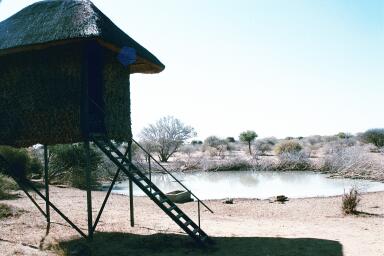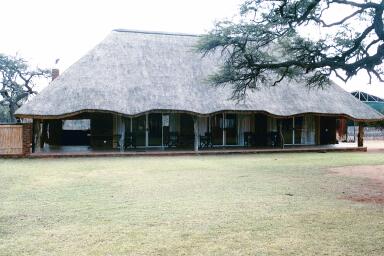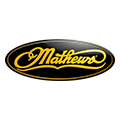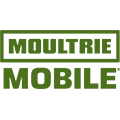Hunt Diary
Day 1 – July 16
I sat the Hartebeest blind on the north ranch (Frost). The blind was
a large, elevated box blind with a thatched roof.
8:30 A.M.: Two warthog sows came in and drank at the waterhole. A
Blacksmith Plover waded in the water.
9:36 A.M.: A sow and piglet warthog came in, drank and fed on a specially-blended
feed mixture that consisted of grain, molasses, and minerals.
10:00 A.M.: A duiker ram drank on the right side of the waterhole at
the edge of the stacked thorn brush. I turned on my camcorder but just
before I was ready to shoot, three warthogs ran in and spooked him.
11:36 A.M.: A steenbok ewe and ram fed about 100 yards east of the
waterhole. The ram had exceptional horns for a steenbok, which were much
taller than his ears.
12:00 Noon: A young gemsbok cow came in and drank. Then a nice waterbuck
bull drank on the right side of the waterhole about 20 yards away. Unfortunately
while he was drinking, he always had his left leg back and I didn’t
take the shot.
1:00 P.M.: Half a dozen eland, including one bull, fed about 100 yards
on the other side of the waterhole. They looked like they were going
to come in and drink but decided not to.
2:00 P.M.: Seven cow and calf kudu came in and watered directly in
front of the blind at about 10 yards away.
3:00 P.M.: Three big mature impala rams came in and drank, licked the
salt block, and fed on the feed. After watching and filming them for
a while, I noted that one of the rams was exceptional and decided to take
him if he offered a shot. Finally, he gave me a nice quartering away
shot at 23 yards. I arrow hit right behind the shoulder and he only ran
about 80-100 yards. He had 25-inch long horns, which is an exceptional
impala ram.
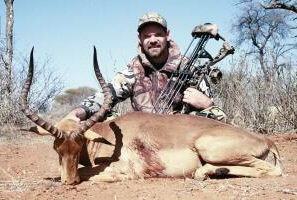
6:00 P.M.: A huge waterbuck bull warily circled the blind at last light
and then came in and drank but was slightly front quartering. So I patiently
waited. He drank for a long time and then started to leave. He made
the mistake of pausing at the edge of the waterhole at about 20 yards
from the blind. At first look, the shot looked a bit high. But when
I played back the video, the angle from my elevated blind looked good.
My worries were alleviated when the PH, Christo, arrived and made quick
work of the tracking. The bull was huge! We measured his horn length
at 29 inches and the horns were very massive. My PH said the bull was
somewhat equivalent to a Boone & Crockett class animal. How exciting!
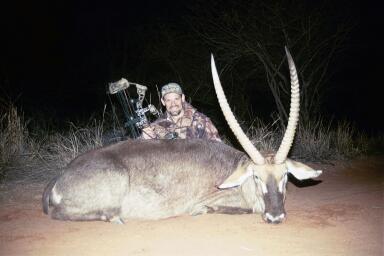
Two tremendous trophies on my first day of bowhunting – it doesn’t
get much better than that. Surprisingly, it would.
Day 2 – July 17
I sat the “Buffalo Stand” on the Frost Ranch. In front
of the blind was a small, manmade waterhole about 10 feet in diameter.
Beyond the waterhole were thick tall trees.
The day was generally uneventful from a bowhunting perspective but I
did see several kudu cows and calves, two nyala ewes, and several warthogs.
Then just before dark, I heard some animals behind me and heard a clicking
noise. One of my friends on the hunt, Ken Asbury, had mentioned that
eland make clicking sounds when they walk as their hooves hit against
each other. But the noise was behind the blind where I couldn’t
see out. Eventually the noise moved around to the left side of the blind
where I could look out a small viewing window. Sure enough, when I peaked
out the window, I saw a herd of eland standing at the edge of the trees
about 60 yards away. My heart jumped into my throat as I saw these animals.
Eland are huge animals, up to 2,000 pounds, and they were on my list of
desired animals. But they just stood at the edge of the trees until dark
when my PH drove up in the vehicle.
Day 3 – July 18
Today I sat the “Impala Blind” on the south ranch (Pete’s).
The blind was an elevated box blind overlooking a small, concrete waterhole
and mineral lick.
8:05 A.M.: A good sized (but not huge) impala ram came in and drank.
As I had already shot one big impala, I passed on this one.
11:20 A.M.: Three nice impala rams came in and drank.
12:00 Noon: Twelve kudu cows and yearling bulls came in and licked
at the mineral lick and fed on the feed. They were entertaining to watch
as they chased each other away from the lick. Then I glanced up and saw
a nice waterbuck bull drinking at the waterhole. Had I not already shot
a waterbuck, I would have tried to take this one.
1:26 P.M.: A huge bodied (actually pot bellied), nice tusked warthog
came in and drank at the same location as the waterbuck. A smaller warthog
sow was behind the big one so I had to wait until she cleared. Then I
shot the warthog low behind the shoulder and the arrow passed completely
through and ricocheted off the ground behind him. I radioed Christo.
Before Christo arrived, I looked up and saw four giraffe approaching
the waterhole. These were the first giraffe I had seen up close and was
enthralled watching them. There were too adult females and two yearlings.
One of the adults came up to the waterhole and tried to drink. But because
she was so tall, she had to splay out her legs to be able to reach the
water. I got some excellent video footage.
Then I heard the vehicle approaching and the giraffe galloped off.
My warthog had only gone about 150 yards but left surprisingly little
blood.
Day 4 – July 19
I was a little stir crazy from sitting in the enclosed blinds so I decided
to sit an open treestand. I had brought my Summit Trophy Chair from the
U.S. and was comfortable sitting all day. The treestand was located in
the thick trees overlooking an area where the outfitter had been placing
some of the feed for the animals. The area was littered with tracks including
zebra, baboon, kudu, gemsbok, waterbuck, and eland. My friend Ken Asbury
had shot a nice kudu bull from this treestand the previous year.
12:00 Noon: The morning had been pretty slow and I had only seen a
few small waterbuck that had winded me. Then I heard an animal approaching
from the opposite side of the feeding area. I looked up to see a lone
gemsbok coming in. And although I find gemsbok one of the most beautiful,
wary, and interesting animals in Africa, I hadn’t planned on shooting
one this year because I had shot a nice bull in Namibia the previous year.
That was until I looked through my Swarovski 8X30 binoculars and saw that
it was a huge bull! His horns were literally about 40 inches long and
very massive. It was the biggest gemsbok bull I had ever seen. Boy did
I get nervous then! He came into the feed area and started feeding slightly
front quartering. But front quartering is definitely not a shot you want
to take on these big, tough animals. Their vitals also lie further forward
than our North America animals. The bull was very wary and kept looking
up and staring at me in my treestand. He fed for a couple of minutes
always keeping an eye on me. Then he must have caught a little of my
scent and spooked without offering a shot. Boy was I frustrated at not
being able to take this bull!
12:45 P.M.: Three small waterbuck bulls came in and fed. A little
later, a nice approximate 27-inch waterbuck followed two other cows into
the feeding area.
5:00 P.M.: About half a dozen bull and cow waterbuck milled about.
6:00 P.M.: Just before dark, the waterbuck looked up and stared in
the direction where the gemsbok had previously come in. Then I heard
that clicking noise again and knew that a herd of eland was coming. First
a big cow came in and fed. Then a huge bull followed and fed front quartering
to me behind the cow. Then several more cows came in and fed. To say
I wasn’t nervous at this point would be a lie. But I tried to contain
my excitement and make the shot if I was offered it. After feeding for
a while, the herd looked up and stared to my right. Then they spooked.
I guess I’ll never know what animal was imposing enough to spook
a herd of full-grown eland. And while I had a fun and exciting day, it
was frustrating not being able to take the huge gemsbok bull or eland
bull. But I guess that’s bowhunting.
Day 5 – July 20
I sat the “Market Place” blind on the Frost Ranch which
is a new ground blind overlooking a small manmade waterhole. Activity
during the day was very slow. It’s always interesting when you
have days like this in Africa. Some days are like watching the Discovery
Channel and other days you don’t see much. And most the time there
is no explanation for it. But I guess if there weren’t some slow
days, it wouldn’t be hunting.
3:20 P.M.: So far I’ve only seen two warthogs and half a dozen
impala rams. But the good news is I have read about 100 pages in my book.
4:45 P.M.: Three kudu bulls just appeared in front of the blind. I
pride myself on usually being able to hear the animals coming and can
usually identify them based on the sound of their gait. But with these
bulls, I didn’t hear a thing. They were just there 15 to 20 yards
away. There were two mature bulls and one young bull. The two mature
bulls both had nice horns. One was wider but didn’t have very deep
curls. The other bull was narrower but had much deeper curls, which is
generally what you look for in a kudu bull. So I elected to take the
latter bull if he offered me a good shot. But whenever the bull I wanted
stopped to drink or feed, it was always a bad angle or there was another
bull behind him.
Finally, the bull I wanted starting feeding at the feed on the left
side of the blind. To shoot this side of the blind, I had to lean forward
from my chair to clear the shooting window. I used my 20-yard pin and
released the arrow. My shot was a little forward but the arrow still
passed behind both shoulders. I radioed Brian, another PH, and he arrived
to the blind about dark. We tracked the bull for about 150 yards and
then decided to come back in the morning to continue the track. Any hunter
who has shot an animal in the evening and had to wait until the following
morning to track it, knows how poorly I slept that night. I was not only
worried about recovering the magnificent animal but also about any of
the scavengers like jackals and hyenas discovering and dining on the kudu.
Day 6 – July 21
Brian, John (a black tracker), and I hit the track early. I just generally
followed behind the PH and tracker wondering what they were looking at.
The blood was good for the first 150 yards but then ran out. Brian and
John split up and started searching various possible routes the bull could
have taken. But there were tracks everywhere in the sand and I couldn’t
understand how they could differentiate the bull from all the other tracks.
But John, who is an unbelievable tracker, was pretty sure he was on the
bull’s tracks. But then we ran into a herd of kudu cows and calves,
which spooked in all directions, complicating matters. But John somehow
followed the bull through all these tracks. About 200 yards further,
he found the bull. The arrow did pass behind both shoulders but was about
3 inches too far forward and must not have punctured both lungs. I was
relieved to recover him though.
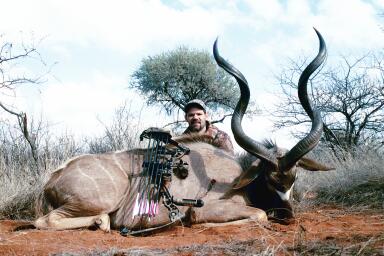
For the evening, I sat a different treestand overlooking a mineral lick
and feeding area. A weather front was moving through and the wind blowing
very hard. I didn’t see much – 4 warthogs, 3 impalas, and
2 kudu cows.
Day 7 – July 22
I sat the Hartebeest Blind on the Frost ranch again. Several small
warthogs came in and fed in the morning.
12:15 P.M.: A real nice impala ram with a smaller ram came in, drank
and licked at the mineral lick. I wasn’t planning on shooting the
bigger ram but he just stood there broadside at 10 yards for about 10
minutes. Finally I couldn’t take it anymore and let him have it.
He only went 80 yards and he had 24-inch horns. Impala are inexpensive
to shoot and make wonderful trophies.
3:00 P.M.: Several warthog showed up including a pretty nice boar.
I probably would have shot him if I hadn’t already taken a warthog.
4:15 P.M.: It’s a good thing I didn’t shoot the warthog
because a herd of eland came in. Had I shot the warthog, it would have
disturbed the waterhole and the eland probably wouldn’t have come
in. The eland drank and then licked at the mineral lick directly in front
of the blind. There were 5 cows and 2 young bulls. But unfortunately,
there weren’t any mature bulls, which was what I was after.
And while I was watching this herd of eland, I glanced to my right and
saw a diminutive duiker ram approach the waterhole. What a shock to the
senses, seeing the huge eland and the small duiker in the same picture.
Since I had not taken a duiker before, I flipped on the camcorder and
grabbed my bow. The ram was at 20 yards drinking. Duikers are notorious
for “jumping the string” but the shot was well placed and
he wasn’t able to dodge the arrow.
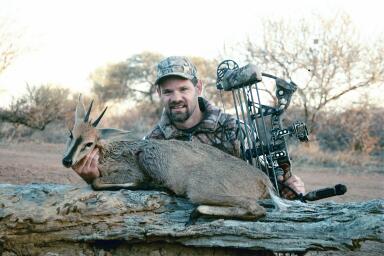
Day 8 – July 23
I hunted the “Baboon Blind” at Pete’s ranch. There
is a windmill and a big large, aboveground water tank that leaks and puddles
up in three locations. The blind is a pit blind overlooking the three
puddles and a mineral block.
Several (12-15) kudu cows and a couple waterbuck cows came in and drank
and fed in front of the blind.
Then a huge warthog boar drank at the water puddle to the left of the
blind. He was quartering to me slightly when he was drinking so I waited.
When he got done drinking he walked up a bank and stood broadside. A
quick shot with my rangefinder showed 24 yards. I released. The boar
reacted to the sound and tried to jump the string. But he was only able
to drop a couple of inches before the arrow reached him. So the hit was
a little high but upon reviewing the shot in my camcorder, looked good.
I radioed Christo and waited for him to arrive. It only took Christo
about 30 minutes to arrive at the blind but vultures had already found
my warthog. Fortunately, they hadn’t chewed on him yet. Apparently
the vultures can ruin a trophy faster than you can blink. They eat the
lips, ears, and eyes first. The warthog had 12-inch tusks.
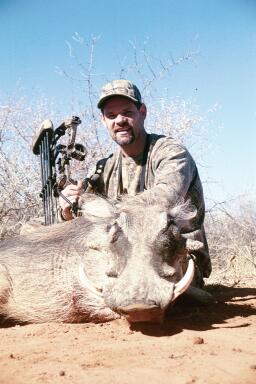
Since I had disturbed this waterhole, I elected to be moved to a new
waterhole for the evening hunt. I really wanted to take a zebra and asked
Christo which waterhole he thought would give me the best chance at one.
To me, zebra are the most difficult animal in Africa to shoot with a bow.
They are extremely wary and generally only come to water at night. In
my 3 years of bowhunting the Dark Continent, I had never seen one at my
waterhole.
Christo thought I would have my best opportunity sitting the “Kudu
Pond” blind. So he moved me to this blind and I sat it until dark.
The blind was another elevated box blind overlooking the left side of
a natural waterhole. Thorn brush had been placed around three sides of
the waterhole so animals had to drink directly in front of the blind offering
a nice, close broadside shot.
2:36 P.M.: So far I have seen 4 warthogs and 7-8 waterbuck including
a nice bull that wouldn’t come all the way in. But it didn’t
matter, I was after striped wildlife.
5:14 P.M.: Well the move paid off! Two zebra stallions came in and
drank and only one left. I can’t believe I finally shot a zebra!
The hit was good and he only made it 60-70 yards from the waterhole.
What a thrill! I’ll never forget peaking out of the small viewing
window as they were coming in and seeing stripes. I thought I was dreaming.
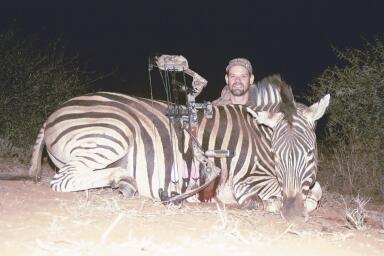
Day 9 – July 24
One animal that I had never taken or even seen before was a blesbok.
These prairie animals intrigued me and I decided to spend my last few
days trying to put a final exclamation mark on my hunt by harvesting one.
One of the problems would be that these animals do not regularly come
to water.
I sat a blind on Pete’s ranch that overlooks a large, dry lakebed
or pan. There is a small waterhole at the east end of the pan. Blesbok,
being prairie animals, enjoy hanging out in the open pan. The blind was
an enclosed, elevated box blind.
9:00 A.M.: Half a dozen impala ewes and rams came in and drank. Two
of the rams were decent. About 80-90 guinea fowl came to water and milled
about in front of the blind. I was tempted to shoot one but didn’t
want to disturb the waterhole.
10:00 A.M.: I was sitting down in the chair where it was difficult
to see out of the blind and glanced up when four blesbok just appeared
directly in front of the blind (15 yards away) near the mineral lick.
As fast as I dare, I turned on the video camera and picked up my bow.
But before I could get a shot, they just walked away without drinking
or offering a shot.
11:30 A.M.: A huge, approximate 13-inch warthog, came in and drank
at the edge of the brush on the waterhole about 30 yards from the blind.
As much as I wanted to shoot him, I decided not to ruin my chances at
a blesbok.
6:00 P.M.: Twelve kudu bulls strolled into the west side of the open
pan at dusk. Half of them were mature, long-horned bulls. It was a thrill
watching them spar with each other. They were extremely wary and did
not come in to drink. They were still standing of the far side of the
pan when my PH arrived in the vehicle at dark.
Day 10 – July 25
Today is my last hunting day and I decided to try some “walking
and stalking.” So at dawn, Christo and I parked the vehicle about
¼-mile west of the open pan and stalked towards it. When we got to the
open pan, we couldn’t believe our eyes. The blind I had sat the
previous day was literally surrounded by blesbok. Aargh!! The open pan
was also loaded with red hartebeest, impala, and kudu. We tried to stalk
around the edge of the open pan to no avail.
By midmorning, as the temperature rose and the animals were likely getting
out of the heat, Christo thought it would be best for me to sit at a waterhole.
So he placed me in the “Baboon Blind” again where a big, lone
blesbok ram had been seen several times before. As we drove up to the
waterhole, we saw the ram standing about 150 yards from the waterhole
in a large meadow.
So I climbed into the pit blind and got comfortable. It being my last
hunt day, I decided to pay particular attention to the waterhole in case
the blesbok decided to water. And I was standing behind the shooting
window watching a waterbuck cow lick at the mineral lick when I crouched
down and couldn’t believe my eyes. The blesbok ram had somehow
snuck in and was watering at the seep about 23 yards to the left of the
blind. I grabbed my bow and drew it as quickly as possible. But before
I could get a shot, the ram just walked away. I tried to grunt with my
voice to stop him but just ended up spooking him. I couldn’t believe
it. I had two opportunities at blesbok watering in 2 days and never got
a shot. Boy did I take some ribbing from Christo later.
Well my hunt was over and I couldn’t believe
the blesbok had outsmarted me. Some animals grow on you during the hunt
and these animals had definitely grown on me. To be honest, I had gotten
a little obsessed about shooting one. But I would have to wait until
next year. Or would I? I recalled that my plane flight out the following
day was not until late evening. So when we got back to the lodge, I dug
out my plane ticket to check the time. The flight didn’t leave
until 8:10 P.M. and it was only a 4-1/2 drive to the airport. So it appeared
I would have time to hunt a few hours in the morning. But I wasn’t
scheduled to hunt that day and didn’t know if the outfitter would
allow it. But I asked him and he said I could hunt until 10:30 A.M. and
then we would need to leave. Boy was I jazzed! I would have one last
chance.
Day 10-1/2 – July 26
I sat the blind on the big open pan again. Of course, even though the
blind was surrounded by blesbok the previous day, none came in. I checked
my watch and it was 10:15 A.M., only 15 minutes of hunting left. It looked
like I was going to go home without a blesbok after all. Then I saw three
blesbok rams walk into the open pan. But they would still need to come
to water for me to get a shot. I waited and the time ticked away. At
literally 10:29 A.M., as I was listening to the vehicle approaching, the
lead blesbok began approaching the waterhole. I tried to quietly call
Christo on the radio but he couldn’t hear my whisper. And just
before the vehicle drove into the pan, the lead blesbok bent down to drink.
It was now or never. I released the arrow and the shot looked good.
Then I quickly called Christo on the radio and told him to wait a few
minutes. The blesbok had only traveled about 90 yards. Christo then
nicknamed me “Last Minute Matt.” What a perfect finish to
a wonderful hunt!
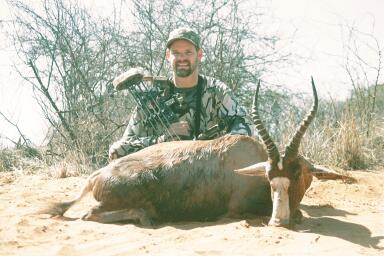
|


